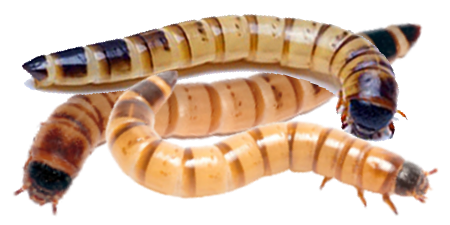



Today’s blog post isn’t about a cool piece of media I wanted to connect to class, but instead a more general look at a handful of creepy-crawlies that have very promising futures as waste management technologies. In the last handful of years, scientists have discovered various critters that have the ability to naturally break down various plastics, from weird worms to fungi to particularly resistant bacteria, all of which provide potentially world-changing solutions that, if harnessed efficiently, can massively reduce plastic waste on several fronts.
First off, a quick description of how exactly these things manage to break down plastic waste better than we can: enzymes. All of these organisms naturally generate enzymes either in their saliva or digestive tracts that are capable of decomposing the polymer chains that make up many types of plastic, many of which are costly for us to synthesize en masse, but clearly beneficial enough to these organisms for them to naturally evolve into this new environmental niche of discarded plastics. As it turns out, when an abundance of plastic in the environment can cause difficulties with obtaining food, maybe the best solution for some creatures is to simply gain the ability to eat the plastic too. If it works, it works!
The first of the organisms I’ll highlight is the waxworm. Two species, Galleria mellonella and Plodia interpunctella, are capable of digesting polyethylene plastic. This is the type of plastic most commonly used in plastic bags and even accounts for about 30% of all plastic production, so if these worms can be harnessed to break down large volumes of plastic waste, they could make a huge impact! I find the anecdote for the discovery of these worms’ abilities particularly fun—reportedly, the discovery was an accident, borne from one of the researchers cleaning out waxworm-infested beehives and later finding that they had not only eaten through the plastic bag they were kept in, but that the damage was both physical and chemical in nature, suggesting that the worms had somehow degraded the plastic beyond simple chewing. Thus, the discovery of the waxworms’ polyethylene-degrading saliva was made. How these worms will be used in the future is a little cloudy, due to high expenses in manufacturing the responsible enzymes, but the options are there.
Similarly, the superworm Zophobas morio has also been found to have similar plastic-degrading abilities. This one, however, can digest Styrofoam (polystyrene), if with some complications—the worms raised on polystyrene diets were a little sicklier than worms fed on bran, but they were still able to complete their lifecycle solely on a diet of plastic. Unlike the waxworm, however, the outlook regarding the synthesis of the responsible enzymes seems to be brighter, with scientists reporting that the next step is to develop past the worms and into a synthetic solution rather than a vague “we could do something with that, probably,” since the worms themselves are a distinctly less economically viable solution.


To leave phylum Arthropoda entirely, next, the fungus Aspergillus tubingensis was found to have the ability to digest polyurethane, yet another variety of plastic most commonly known as flexible foam-type materials. This one was discovered in a landfill in Pakistan and later found to secrete an enzyme that decomposes the bonds between plastic polymers much like the worms. On top of that, however, the fungus also physically uses its mycelia (the filaments fungi are made of) to push apart those polymer chains, so it’s theoretically even more effective at plastic decomposition. The next step for harnessing this fungi is to identify the conditions where it works the best, so that it can potentially be utilized on a large scale for cleaning up polyurethane.

The last organism is a bacterium, a new strain of Pseudomonas bacteria, which also decomposes polyurethane like the A. tubingensis fungus. Also similarly to the fungus, since this is a strain of bacteria, it will hopefully be a lot easier to use on a large scale than the worms, which will almost certainly need to have their enzymes isolated, synthesized, and eventually produced on a large scale to be effectively used. Fungi or bacteria can theoretically just be ‘let loose’ essentially on the plastic to degrade it instead. The biggest concern from this method, though, is dealing with the toxic byproducts of breaking down the plastics—the key feature that makes these bacteria cool in the first place is that they can withstand said toxins!
In conclusion, bugs are super cool for several reasons and a fun new one that has come to light in recent years is how good some of them are at decomposing several varieties of plastics. Hopefully these organisms will be used into the future to handle plastic waste.
 ←
←